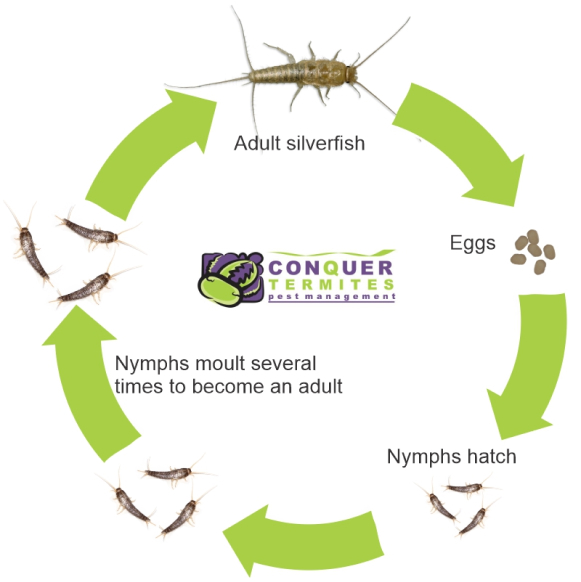How to treat silverfish
Silverfish are considered household pests due to their consumption and destruction of property. However, although they are responsible for food contamination and other types of damage, they do not transmit disease.

What do silverfish look like?
Silverfish are nocturnal insects typically 13–25 mm (0.5–1.0 in) long.[1] Their abdomens taper at the end, giving them a fish-like appearance.[2] The newly hatched are whitish but develop a greyish hue and metallic shine as they get older.[3] They have two long cerci and one terminal filament at the tip of the abdomen between the cerci.
A silverfish (Lepisma saccharina) is a small, primitive, wingless insect in the order Zygentoma. Its common name derives from the animal’s silvery light grey colour, combined with the fish-like appearance of its movements. The scientific name (L. saccharina) indicates the silverfish’s diet consists of carbohydrates such as sugar or starches.
Source: Wikipedia
Lifecycle of the silverfish
Silverfish go through a three-stage life cycle called gradual metamorphosis, whereas most insects have a four-stage life cycle (complete metamorphosis). The life cycle from silverfish egg to adult is three to four months.
Silverfish can lay eggs at any time during the year. The female lays groups in small batches, usually deposited in small crevices in dark places. The eggs take 2 – 8 weeks to hatch.
When the nymphs hatch, they are whitish in colour, and look like smaller adults. As they moult, young silverfish develop a greyish appearance and a metallic shine, eventually becoming adults after three months to three years.

You find Silverfish inside, usually in dark, damp undisturbed areas. You rarely see them outside.
Silverfish love to eat anything made of carbohydrates such as sugar or starches. These include book bindings, carpet, clothing, coffee, dandruff, glue, hair, some paints, paper, photos, plaster, and sugar. Other substances they may eat include cotton, dead insects, linen, silk, leftover crumbs. So be aware your library of old books might be under attack!
*Silverfish can live for a year or more without eating if water is available.
Silverfish love to eat anything made of carbohydrates such as sugar or starches. These include book bindings, carpet, clothing, coffee, dandruff, glue, hair, some paints, paper, photos, plaster, and sugar. Other substances they may eat include cotton, dead insects, linen, silk, leftover crumbs. So be aware your library of old books might be under attack!
*Silverfish can live for a year or more without eating if water is available.
Silverfish love to eat anything made of carbohydrates such as sugar or starches. These include book bindings, carpet, clothing, coffee, dandruff, glue, hair, some paints, paper, photos, plaster, and sugar. Other substances they may eat include cotton, dead insects, linen, silk, leftover crumbs. So be aware your library of old books might be under attack!
*Silverfish can live for a year or more without eating if water is available.
1.Regularly vacuum every room.
2.Pull out books and clothes to dust and check.
3.Put all food, especially carbs and starches, in sealed containers.
4.Don’t store piles of paper in and dark, damp area
5.Regularly vacuum every room.Air the house regularly to reduce dampness and humidity – open windows.
Conquer Termites silverfish treatment
Conquer Termites treats Silverfish in its General Pest Control Package by applying a safe and effective controlling spray along the skirting boards and inside wall robes. Also, we do a roof void dusting from the manhole.




